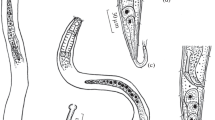Summary
Morphological differences between the cyst-forming species ofHerodera are briefly discussed. Examination of many populations and experience in practical survey and advisory work have shown, that the 6 important species in the Netherlands can be separated on the base of cyst shape. These differences are more difficult to describe than to observe in vivo (Figs. 1–5). The length of the larval tail (i.e. the clear portion of the tail from the tip to the body cavity) and additionally also other characters, serve as a valuable check.
The following key is advertised for practical determination work:
-
1.
Cysts pear-shaped, i.e. with rounded lower end of body ... Cysts lemon-shaped, i.e. with cone-shaped lower end of body and vulva on top of the cone ...
-
2.
Cysts excluding neck oblong; anus and vulva each on a conspicuous thin spot in the cyst wall; larvae with very long and thin tail ...H. punctata Cysts excluding neck nearly round; vulva on a conspicuous thin spot in the cyst wall, anus scarcely visible; larval tail of about the same length as spear...H. rostochiensis
-
3.
Cysts very small, relatively thick and round, reddish brown; larvae short and thick (length: breadth ratio±20)...H. cruciferae Cysts not very small; larvae not short and thick...
-
4.
Cysts rather slender, bluntly lemon-shaped with scarcely protruded vulva cone, shining reddish brown; larvae with long, thin tail (±11/2×spear length)...H. goettingiana Cysts with definitely protruded vulva cone...
-
5.
Cysts broad with short vulva cone; cyst wall brown to black; larval tail long (±11/2×spear length)...H. avenae=H. major Cysts with conspicuous, slender vulva cone, light brown; larval tail 1−1/4 ×spear length...H. schachtii
Résumé
Les différences morphologiques entre les espèces de Heterodera formant des kystes sont brièvement discutées. L'examen d'un grand nombre de populations et l'expérience acquise dans la pratique et dans le service de renseignements ont démontré que les 6 espèces principales des Pays-Bas peuvent être divisées suivant la forme du kyste. Il est plus difficile de décrire ces différences que de les observer in vivo (Fig. 1à 5). La longueur de la queue des larves (c. à d. la partie de la queue depuis la pointe jusqu'à la cavité du corps) et d'autres caractéristiques encore constituent des marques de valeur.
La clef suivante peut servir pour la détermination pratique:
-
1.
Kystes piriformes, c. à d. avec abdomen arrondi... Kystes en forme de citron, c. à d. avec abdomen se terminant en pointe allongée, tandis que la vulve se trouve au sommet du cône...
-
2.
Kystes, sans le cou, ovales; l'anus et la vulve l'un et l'autre dans de larges taches claires de la paroi du kyste; queue des larves très longue et mince ...H. punctata. Nématode des graminées Kystes, sans le cou, sphériques; vulve dans une large tache claire mais l'anus à peine perceptible; queue des larves une peu plus longue que le stylet ...H. rostochiensis. Nématode de la pomme de terre.
-
3.
Kystes surprenant par leur petitesse, ventrus, teinte rouge brun; larves trapues et épaisses (rapport longueur: largeur±20) ... ...H. cruciferae. Nématode du chou. Kystes ne surprenant pas par leur petitesse, larves pas trapues et épaisses
-
4.
Kystes assez élancés en forme de citron sans pointe mais abdomen pas ou à peine en pointe allongée; teinte rouge brun luisante; queue des larves longue et mince (±11/2×la longueur du stylet)... ...H. goettingiana. Nématode du pois. Kystes avec le cône de la vulve en pointe allongée...
-
5.
Kystes larges renflés jusqu'à proximité de la vulve, cône de la vulve petit, paroi du kyste le plus souvent brun foncé ou noir; larves avec longue queue (±11/2×la longueur du stylet)... ...H. avenae=H. major. Nématode de l'avoine. Kystes avec cône de la vulve en pointe allongée et élancée, teinte brun clair; queue des larves 1 à 11/4×la longueur du stylet... ...H. schachtii. Nématode de la betterave.
Similar content being viewed by others
Geciteerde Literatuur
Franklin, M. T. — 1940. On the identification of strains of Heterodera schachtii. J. Helminthology 18:63–84.
Franklin, M. T. — 1951. The cyst-forming species of Heterodera. Commonwealth Agricultural Bureaux, Farnham Royal, Bucks, England.
Goffart, H. — 1934. Die Bestimmung von Rüben-, Hafer- und Kartoffelnematoden auf Grund von Bodenuntersuchungen. Z. Pfl.-Krankh. und Pfl.-schutz 44:36–41.
Hellinga, J. J. J. — 1943. Verslag over het onderzoek van grondmonsters op bietencystenaaltjes, verricht in samenwerking met de suikerfabrieken in 1941 en 1942. Versl. Inst. Rationele Suikerproductie 13:47–66.
Jones, F. G. W. — 1950. Observations on the beet eelworm and other cyst-forming species of Heterodera. Ann. app. Biol. 37:407–440.
Oostenbrink, M. — 1950. Het aardappelaaltje (heterodera rostochiensis Wollenweber), een gevaarlijke parasiet voor de eenzijdige aardappelcultuur. Versl. en Meded. Plantenziektenkundige Dienst No 115.
Oostenbrink, M. &Ouden, H. den — 1953. Het koolcystenaaltje, Heterodera cruciferae Franklin, 1945, in Nederland. T. Plantenziekten 59:95–100.
Peters, B. G. — 1952. The eelworm problem: biological aspects. Plant eelworms of the genus Heterodera. Chemistry and Industry 1952:994–995.
Taylor, A. L. — 1950. Getypte mededeling van de Division of Nematology, Plant Industry Station, Beltsville, Md., U.S.A.
Author information
Authors and Affiliations
Additional information
Instituut voor Rationele Suikerproductie, Bergen op Zoom.
Rights and permissions
About this article
Cite this article
Hijner, J.A., Oostenbrink, M. & den Ouden, H. Morfologische verschillen tussen de belangrijkste heterodera-soorten in nederland. Tijdschrift Over Plantenziekten 59, 245–251 (1953). https://doi.org/10.1007/BF02151181
Received:
Issue Date:
DOI: https://doi.org/10.1007/BF02151181




